Which Of The Following Shows The Four Jovian Planets Correctly Scaled In Size?
ASTR 1210 (O'Connell) Study Guide 20
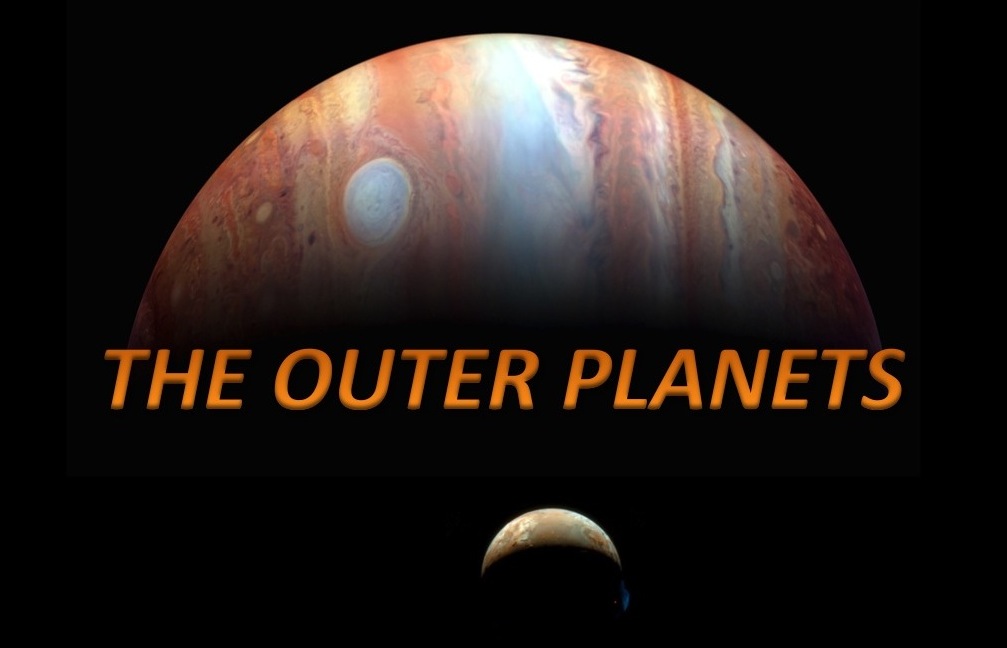
Jupiter with erupting Io in foreground
(New Horizons Mission image)
"And at present for something completely different," as they used to say on Monty Python. The outer solar system is different indeed.
The outer solar system we can at present explore (out to nearly l AU) is vast -- over 35,000 times the volume of the terrestrial realm out to Mars -- and sparsely populated.
The iv large "Jovian" planets (Jupiter, Saturn, Uranus, and Neptune) are entirely unlike the terrestrial planets (see more discussion in Study Guide 11). They may have rocky cores, like larger versions of the World, at their centers, only these are enveloped in giant gaseous atmospheres. Only the outermost skins of these atmospheres can be studied direct. This is meteorology, instead of the geology/topography we discussed for the terrestrials. Notwithstanding, it can be just as extreme with respect to Globe-spring meteorology as are the canyons and mountains of Mars compared to those of Earth.
Another major distinction of the Jovians is the large number of satellites they possess. The satellites, observed at close range by spacecraft, display an astonishing diversity of surface types and features. Unlike the three terrestrial planet satellites, the larger Jovian satellites are rich in h2o ice and showroom many unlike phenomena as a issue. They may even harbor biospheres. The ring systems, which are present around all 4 Jovians, are probably the remnants of distintegrated satellites.
Many examples of a 3rd kind of planet have recently been discovered exterior the orbit of Neptune. These are perhaps most aptly called the "water ice dwarf planets," of which Pluto is the classic.
A. History of Discovery/Exploration Beyond Mars
- Prehistory: Jupiter, Saturn known 1610-1700: Galileo discovers iv large satellites in orbit around Jupiter. Later on in the 17th century Huygens and Cassini find the rings and several large satellites of Saturn and the blood-red spot on Jupiter. 1704: Edmond Halley determines the orbit of the eponymous comet and discovers that it travels as far as 35 AU'south from the Sun --- into an unexplored realm far beyond the virtually distant planet known at the fourth dimension (Saturn, at 9.5 AU's). 1781: Amateur astronomer William Herschel discovers Uranus (accidentally) using a small telescope---the beginning new planet in recorded history. Its orbital semi-major centrality is nineteen AU'southward. (Drawing on royal patronage because of his subsequent fame, Herschel became a remarkably productive professional astronomer.) 1790+: Deviations in Uranus' orbit, assumed to be caused past the gravitational allure of yet some other (unknown) planet, lead to a prediction of its location based on Newton's theory of gravity. 1845: Neptune is discovered, as predicted, at 30 AU from the Sun --- a triumph of Newtonian mechanics 1930: Working at Lowell Observatory, Clyde Tombaugh discovers Pluto. A much more difficult proffer than Neptune because information technology is 700 times fainter, both because it is much smaller and has an orbital semi-major axis of 39 AU'due south. Tombaugh had been an amateur astronomer earlier being hired by the observatory. He was merely 24 at the time and did non yet take a college degree.
- Although the search for Pluto followed the methods established for Neptune, based on apparent abnormalities in the orbits of Neptune and Uranus, it speedily became clear that its discovery was accidental: Pluto is too modest to take afflicted the other planets' movement significantly, nor were the claimed distortions in their orbits accurate. Pluto also broke the pattern established by the iv other planets across Mars (Jupiter, Saturn, Uranus, and Neptune): it was not a gas giant planet. Instead, information technology was and then pocket-sized it could not be resolved by telescopes of the fourth dimension and showed indications of having a rocky surface.
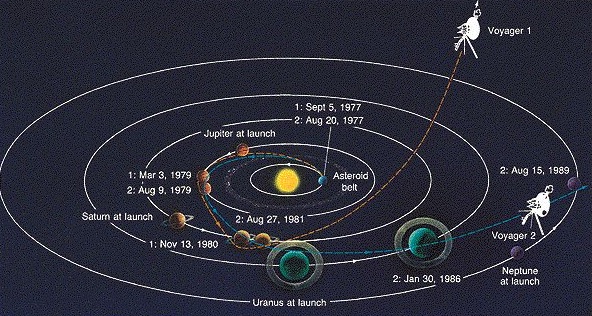
Flyby orbits of Voyager Missions to outer planets

Spacecraft images of the four Jovian planets (from left: Jupiter, Saturn, Uranus, Neptune),
scaled to their correct relative sizes (but non distances from the Sun).
B. Jovian Planets: Properties
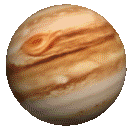 The four Jovian planets share gross properties. Pluto is entirely different (come across beneath).
The four Jovian planets share gross properties. Pluto is entirely different (come across beneath).
Distant from Sun: 5-30 AU. (Pluto is at 39 AU.)
Large: The Jovians are 4-11 times larger in diameter than Globe. Jupiter's volume is 1300 times the Earth's. Masses are 15(U)-318(J) times Earth'due south. Jupiter contains twice as much mass equally all other planets combined. An animated timelapse image of Jupiter's rotation and surface features is shown at the right. Click on the image for a more than current, high resolution video.
- Jupiter is midway between terrestrial planets and stars on a power of ten mass scale. Objects but thirteen times more massive are considered to be small stars, not planets.
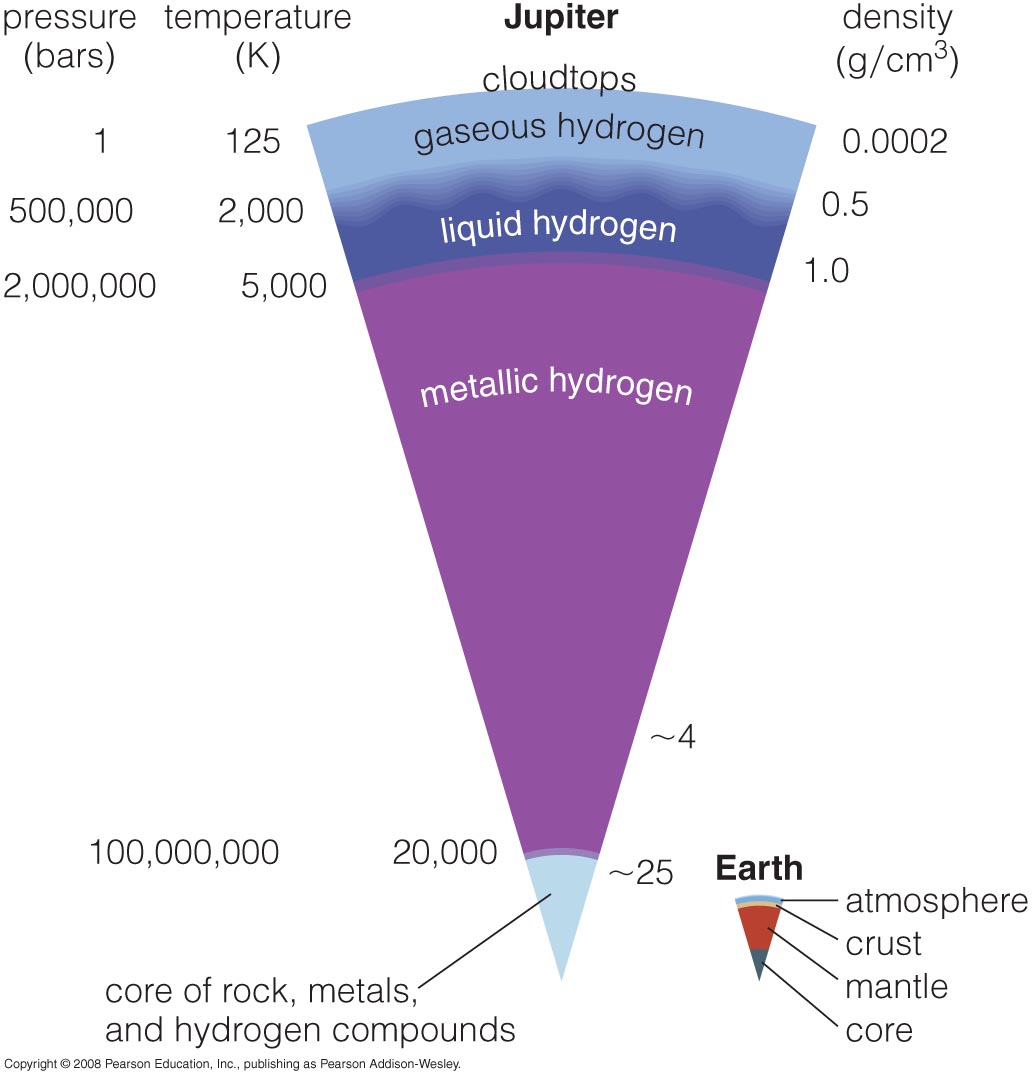
Structures
- Their low mean densities (~ 1 gram/cc) imply that Jupiter and Saturn are mainly composed of H and He, with simply modest rocky cores, perhaps Globe-size. That is a product of their formation out of the absurd regions of the solar nebula, which were dominated by icy (H-rich) solids. Uranus and Neptune take larger fractional complements of heavy elements than Jupiter and Saturn.
- Internal structures are entirely unlike from terrestrial planets considering of their predominant hydrogen composition. Click on the Jupiter cantankerous-exclusive drawing at correct for an enlarged version. The high internal pressures in Jupiter and Saturn catechumen hydrogen gas to liquid or "metallic" form in their interiors. The lower-pressure level interiors of Uranus and Neptune comprise mantles composed of ammonia, methane, and water. Unlike Terrestrial planets, the Jovians have no solid surfaces. They are "gas giants".
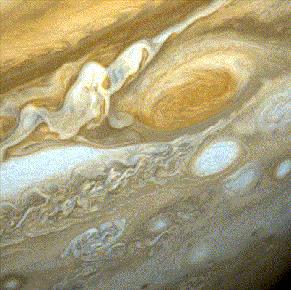
Visible Surfaces
- The visible surfaces of the Jovians are cloud layers, almost 150 miles deep. The clouds consist of 3 main types of ice crystals: ammonia, ammonium hydrosulfide, and water. Colors are from trace compounds. Sparse, white clouds on Neptune are methane crystals, which freeze out at the lower atmospheric temperature in that location.
- "Spots": The nearly famous is Jupiter'southward Red Spot (the big oval in the image at right: 22,000 mi long ~ 3x Earth's bore). It is a long-lived cyclonic storm. The transient "Great Night Spot" on Neptune was a similar feature, and many smaller spots or ovals, mostly transient and ranging from dark red to white in color, are visible in the Jovian atmospheres (nearly conspicuous on Jupiter; 8 are nowadays in the epitome at the right).
- Atmospheric banding is caused past powerful lateral windstreams fed by rising/falling convection currents. Winds reach 300-600 mph on Jupiter and Saturn and upwards to 1300 mph on Neptune. See the enhanced pseudocolor image of Saturn'due south atmospheric banding below right.
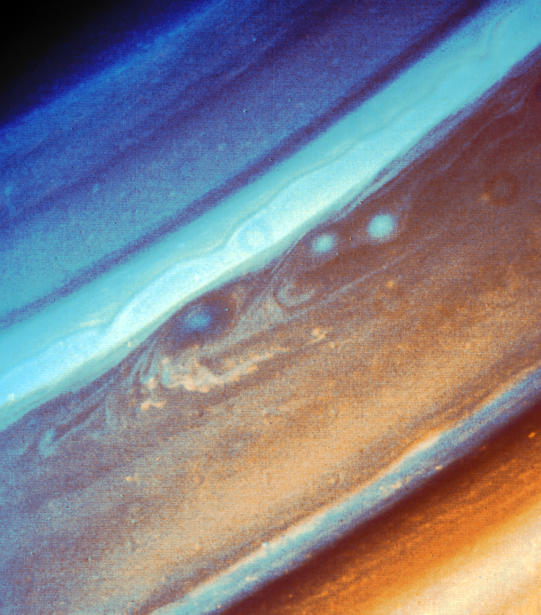
- The Juno spacecraft, skimming in an elliptical orbit to within 2600 miles of Jupiter'due south deject layers, is now returning amazingly detailed images of the atmosphere.
- Hither is a beautiful recent Juno epitome of Jupiter'south Red Spot with Io in the foreground, casting a shadow.
-
 Videos of Jupiter atmosphere:
Videos of Jupiter atmosphere: - Voyager i "Blue Movie" (time lapse of approach to planet)
- Voyager 1 Red Spot Motion-picture show
- Cassini Full Surface Motion-picture show
- Videos from Juno mission
Special Probes of Jupiter
- Comet Shoemaker-Levy-9: was captured by Jupiter and hit the planet in 1994. The impact acted every bit a "natural" atmospheric probe; infalling fragments produced multiple enormous, concentrated energy releases in the temper. The explosions were bright and the scars long-lived.
- The Galileo spacecraft probe was sent into Jupiter'southward atmosphere in 1995 and returned pressure, temperature, and limerick profiles to a depth of about 100 miles before information technology was crushed by the pressure.
Magnetospheres
- Potent magnetic fields are generated past motions in the liquid metallic hydrogen interiors of Jupiter & Saturn. Because the magnetic fields trap energetic protons and electrons, these produce powerful radiations belts, upwardly to 100x stronger than those of World.
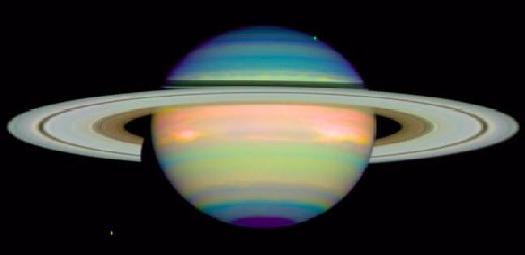
Pseudo-color infrared prototype of Saturn
C. Ring Systems
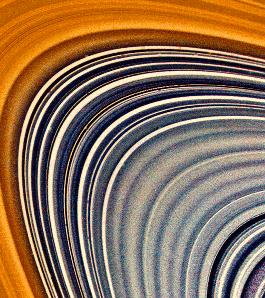 Saturn has the brightest rings, but rings are nowadays around all 4 Jovians
Saturn has the brightest rings, but rings are nowadays around all 4 Jovians
- The rings are not solid: the inner rings revolve faster than the outer ones, as expected for objects in Keplerian gravitational orbits
- The rings are huge in width but by comparison are remarkably thin, mostly less than 1 km (3300 feet) thick. They have an attribute ratio of nigh 300,000:1. This is over 110 times thinner than standard printer paper. Here is an article on the ring geometry by Phil Plait.
- The rings are composed of billions of water ice-coated particles (typically about 10 cm in size). Dissimilar particle sizes and coatings produce some of the structure visible in the rings.
- Origin: the rings are primarily droppings from tidally or collisionally fragmented satellites
- The rings lie inside the planet's "Roche Limit" . Closer than this altitude from the planet'south core, gravity tides would pull apart a large body, such as a satellite.
- The rings have a complex structure (at correct), consisting of numerous gaps and ringlets. The biggest gaps are "resonance" effects produced by the cyclical gravitational tug of the satellites outside the ring. The ringlets may exist produced by the cocky-gravity of the material in the rings.
-
 A video of Saturn's rings from the Cassini mission
A video of Saturn's rings from the Cassini mission

Spacecraft images of the four Galilean satellites of Jupiter, shown to scale
(Io, Europa, Ganymede, and Callisto).
D. The Jovian Planet Satellites
In many means, the satellites of the Jovian planets are more interesting than the planets themselves. The four largest satellites of Jupiter (the "Galilean satellites") were discovered by Galileo and were the kickoff additions to the planetary inventory of the Solar Arrangement in recorded history. Galileo saw them merely equally points of light, and skilful information on their surfaces was non obtained until the spacecraft flyby missions of the 1970'south and lxxx's.
The composite picture above shows spacecraft images of the four Galilean satellites (scaled to the correct relative sizes). Information technology illustrates the outstanding characteristic of these four satellites: they are amazingly dissimilar from one another. Each is a unique world in its own correct. They are typical of all Jovian satellites in that they are various, and they often accept had violent histories.
Here are some of the other characteristics of the Jovian satellites:
- The satellite complement for a given planet is large: fourteen-79
- Two are larger than Mercury. See this comparison of satellites and planets.
- The large moons formed at the same time as their parent planet
- Because of their large ice content, their surfaces are more plastic than those of the terrestrial planets; some show all-encompassing testify of melting and resurfacing.
- Nearly of these are rocky or icy planetesimals/asteroids, which were gravitationally captured by a planet over time.
 Click here for a Java animation of orbits of the satellites of each planet
Click here for a Java animation of orbits of the satellites of each planet 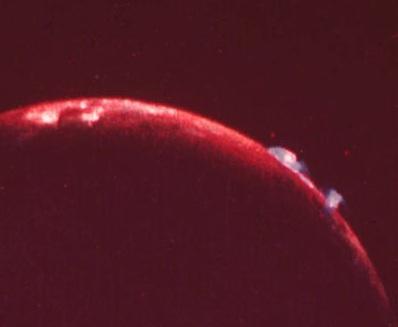 Important examples of satellites: (click on the names for additional illustrations)
Important examples of satellites: (click on the names for additional illustrations)
- Io (J): Io is the innermost of the 4 Galilean satellites of Jupiter. Information technology suffers continual volcanic eruptions caused by heating from tidal flexing in Jupiter'due south gravitational field. Io is much more agile today than even the Globe. There are presently over 400 active volcanoes on Io. Its huge volcanic plumes at the time of their discovery by Voyager 1 in 1979 are shown at the right.
- Europa (J): The second Galilean satellite is completely ice-coated and extraordinarily smooth (i.e. has a small range of peak). Few craters, indicating a young surface. Well-nigh scientists believe the water ice shell covers an underlying ocean, kept warm by tidal flexing (less severe than for Io). Long, dark lines on the surface may be places where the vanquish has croaky, allowing filling by younger ice. In 2013, NASA announced the detection of water vapor plumes jetting off of Europa's surface (like the similar features found before on Enceladus). Because of the presence of water, there is much speculation nigh a possible biosphere on Europa (see Study Guide 23).
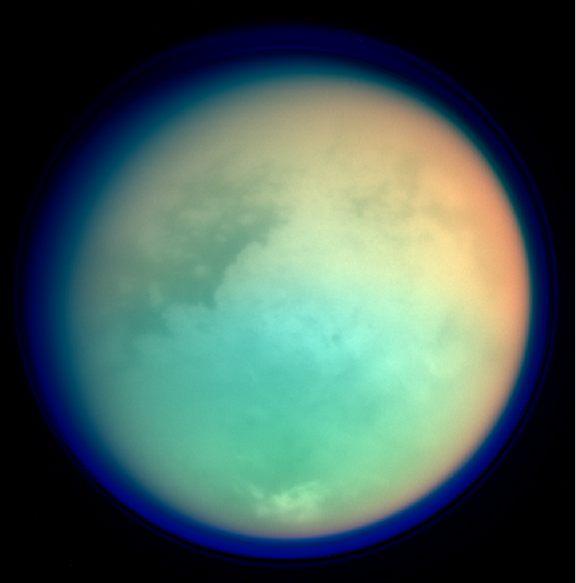
- Titan (S): Saturn's largest moon has a thick temper(!), visible equally a blue haze in the infrared image at the right. Information technology is mostly nitrogen with a small amount of methyl hydride. Titan is the only object in the Solar Arrangement other than Earth to have a predominantly nitrogen temper. The temper can be retained, despite Titan's small mass, considering of its low temperature at Saturn's distance from the Sun.
- Titan was the chief target of the European Cassini-Huygens Mission. While the primary spacecraft stayed in orbit effectually Saturn, the Huygens probe was detached and successfully landed on Titan's surface in Jan 2005, relaying data during its descent and for a short period on the ground. Solar UV light interacting with marsh gas has produced a rich mixture of hydrocarbon clouds and obscuring brume. There is probably hydrocarbon pelting on Titan. Click hither for an atmospheric profile. Recent radar data from the orbiting Cassini spacecraft shows that there are large lakes on Titan, probably of marsh gas or ethane. In company with Europa and Enceladus (run into beneath), Titan is at present regarded as a possible site of a biosphere --- but with lifeforms based on utilizing methane rather than carbon dioxide.
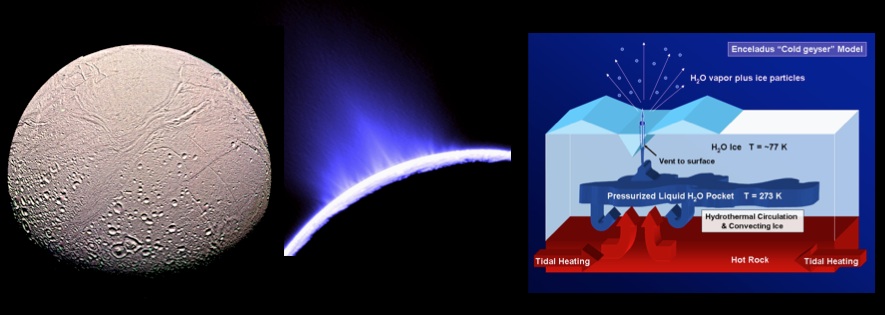
Left: Enceladus; Heart: water vapor plume from Enceladus; Correct: possible internal structure of Enceladus
- Enceladus(S): Although only a pocket-sized satellite, Enceladus became a focus of astronomer involvement when information technology was unexpectedly discovered by the Cassini orbiter to possess huge water/ice geysers jetting into space from its surface. The plumes incorporate water vapor, circuitous hydrocarbons, and sodium salts. The plumes are thought to originate from warm liquid h2o reservoirs below the surface which are heated past tidal flexing; jets escape through deep vents. See the picture to a higher place. The outflow from Enceladus feeds material into Saturn's "East ring."
- In April 2014, scientists appear that gravity measurements deduced from tiny accelerations of the Cassini spacecraft in the vicinity of Enceladus ostend the presence of a liquid ocean with a volume comparable to Lake Superior lying under its s pole.
- Miranda (U): has a remarkable patchwork surface, probably from a shattering collision & reassembly or possibly surface scars from internal convection
 Animation of Miranda'southward terrain
Animation of Miranda'southward terrain - Triton (N): the largest satellite of Neptune is a captured KBO. (It has a "retrograde" orbit -- information technology orbits in the opposite direction to Neptune's spin -- implying it did not class with Neptune but was gravitationally captured later on.) Triton has a young, nitrogen-rich surface with diverse structural features caused by water ice melting, shifting, and re-freezing. During Voyager ii'southward brief passage, it featured several geysers or "cryovolcanos" of nitrogen, methane, ice, and grit jetting out of its surface. Its surface has much in common with Pluto's (see below).
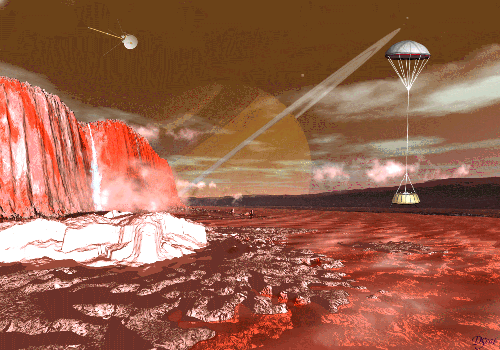 Artist's Concept of Huygens Probe Landing On Titan
Artist's Concept of Huygens Probe Landing On Titan E. Pluto and the Kuiper Belt
Pluto is entirely dissimilar the four large outer planets. With a diameter of just 1475 miles, it is smaller by a gene of 2 than whatever of the terrestrial or Jovian planets. Information technology is a rocky/icy object rather than a gas giant. Its orbit is the most highly inclined to the ecliptic plane of any of the classical "ix planets."
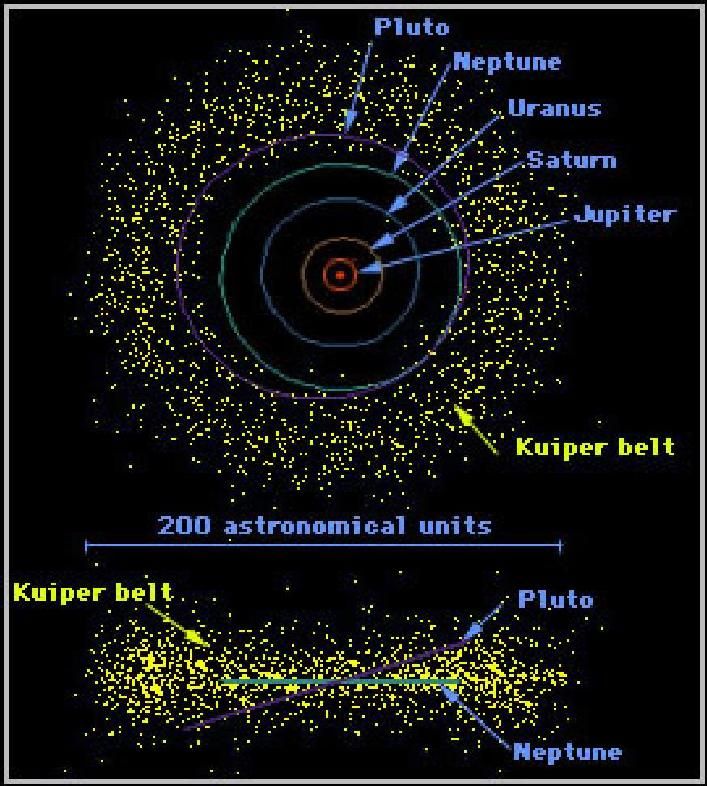 When first discovered, Pluto was idea to be isolated at the edge of the Solar System. However, in the last 25 years, later wide-field digital detectors were installed on large telescopes, astronomers have identified many more than like bodies, some with sizes comparable to Pluto. These, including Pluto, are all members of the "Kuiper Belt".
When first discovered, Pluto was idea to be isolated at the edge of the Solar System. However, in the last 25 years, later wide-field digital detectors were installed on large telescopes, astronomers have identified many more than like bodies, some with sizes comparable to Pluto. These, including Pluto, are all members of the "Kuiper Belt".
- The Kuiper Chugalug is a huge volume beyond the orbit of Neptune, centered on the ecliptic plane, simply extending many AU's above and below the plane. Information technology is much larger than the asteroid chugalug, which lies between Mars and Jupiter. Over chiliad "Kuiper Belt Objects" (KBO'due south) have been discovered in this book to appointment. A number of these are larger than any of the asteroids; Pluto, for example, is 2.five times the bore of Ceres, the largest asteroid. Here is a comparing of the viii largest KBO'south and their satellites to one another. The plot at the right shows the known KBOs with the Belt both face-on and edge-on (click for an enlargement).
- The well-nigh massive known KBO---yes, it's more massive than Pluto---is Eris, also the 2d well-nigh afar known KBO (97 AU). Information technology was discovered in 2005. Its size (1400 miles diameter) is slightly smaller than Pluto'due south. Click here for a page describing Eris by its discoverer, Mike Dark-brown.
- Sedna, a 600-mile diameter object discovered in 2003, has an aphelion (greatest orbital distance from the Sunday) of 937 AU, although at nowadays it is at only ninety AU. Its orbital menstruum is about 11,400 years. Information technology is afar enough that it may be a member of the "Oort Deject" rather than the Kuiper Belt. The object 2012 VP113 is similar to Sedna, with a perihelion (minimum orbital altitude from the Dominicus) of 80 AU, currently the virtually distant perihelion of any Solar System trunk. Some of the known KBO orbits are shown individually here.
These discoveries, especially that of Eris, precipitated the messy discussion at the International Astronomical Union in the summer of 2006. Astronomers held a fence over the meaning of the term "planet"---specifically whether or not Pluto and the other big KBO's should be placed in a separate category. In the end, the IAU voted to create a new category of "dwarf planet" for these objects but was and so forced to add the asteroid Ceres for consistency. All this was handled very clumsily, and it generated needless controversy. It turns out many non-astronomers were fond of Planet Pluto and protested the demotion.
Long earlier the discovery of Pluto, we had already identified many "pocket-sized planets" or "asteroids," small, rocky objects with orbits lying mostly between the orbits of Mars and Jupiter. Now, we know most many like, but icy, objects beyond Neptune. Sensible designations for these types, above some threshold in size, are as "rock dwarf planets" and "water ice dwarf planets," respectively.
The Pluto Flyby
New Horizons, the first mission to Pluto and the Kuiper Belt, was launched by NASA in 2006 and, having received a gravity help from Jupiter, finally reached Pluto on 14 July 2015. (Aye, nine years later. The fact that New Horizons was launched with the brisk velocity of over 36,000 miles per hour gives you some appreciation for the scale of the solar system.) The spacecraft could not carry enough fuel to decelerate into orbit around Pluto (that would take fabricated information technology much more than massive and expensive), so it was always planned as a "flyby," with a closest approach of near 7800 miles. It took over 15 months for all the data collected during the brief flyby to be telemetered dorsum to Earth.
- New Horizons returned a wealth of information on the surface and temper of Pluto and the nature of its five satellites. Although the strangeness of Pluto's surface was anticipated past the 1989 Voyager images of Neptune's moon Triton, the close-range, high resolution imaging of New Horizons revealed amazing features.
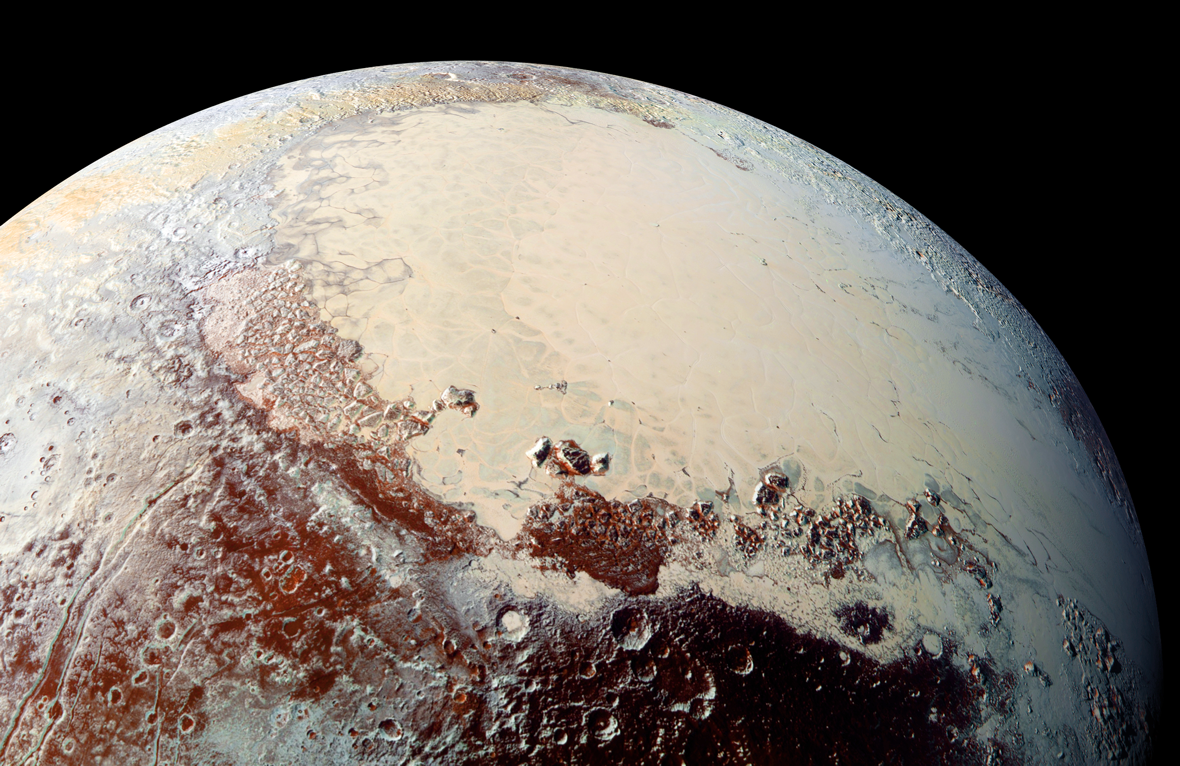
- Much of the surface is covered past rugged terrain (reddish-brown in the epitome in a higher place), with mountains ranging upward to 16000 feet high. The surface is not made of rock, however --- rather of a mixture of ices of nitrogen, water vapor, carbon monoxide, and methane, which have frozen out at the very low temperature of Pluto (-230C). The cratering density in the mountainous regions indicates ages upwardly to 4 billion years sometime. The shine, calorie-free-colored regions in the epitome higher up (part of the heart-shaped "Tombaugh Regio") most entirely lack cratering and are therefore much younger, less than 10 million years old. They consist mainly of frozen nitrogen and carbon monoxide. The surface is cleaved into polygonal cells (meet image below correct), which bespeak relatively recent convective motions.
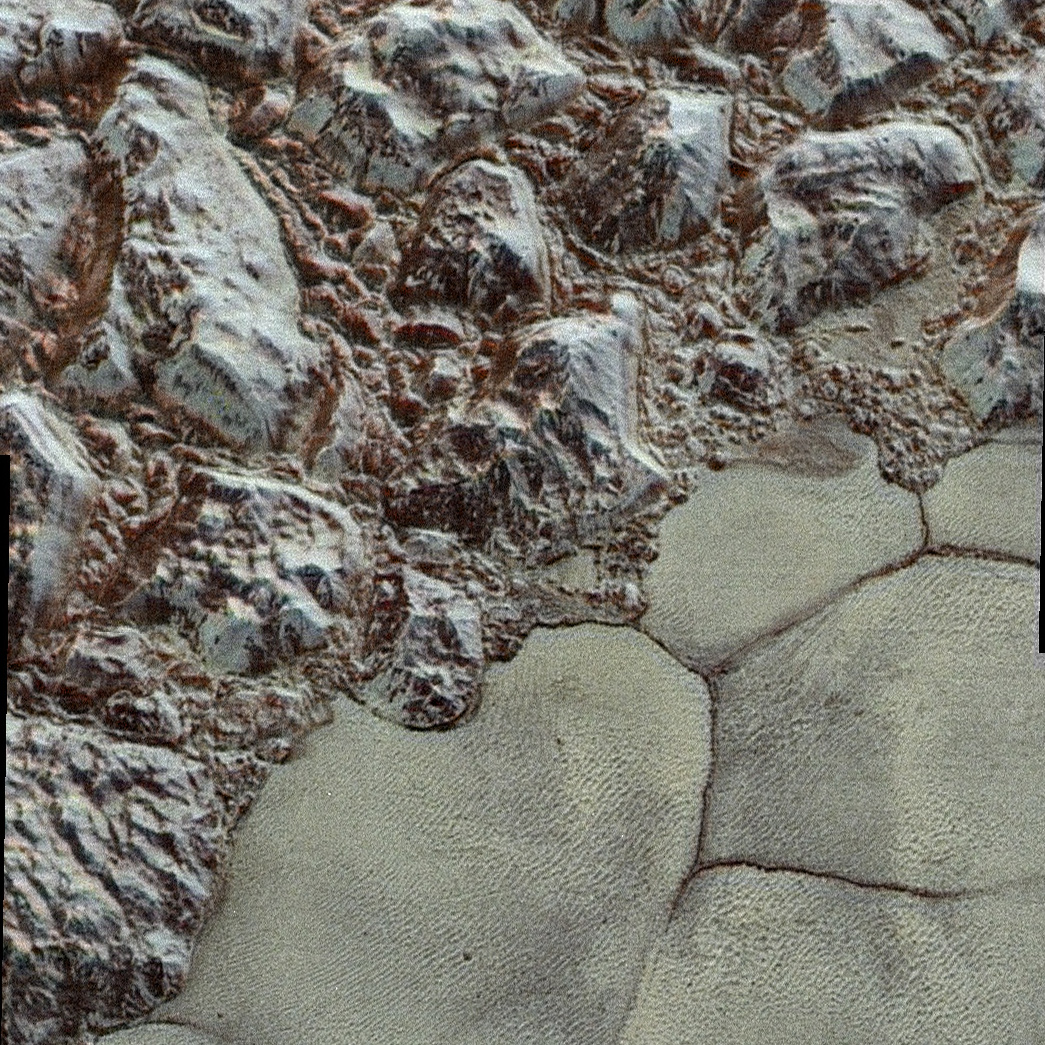 The forcefulness of the rising ice was apparently enough to float the mountains of water ice lying at the margins of the region. Overall, Pluto is revealed every bit much more than geologically active than expected, with exchanges continuing to occur betwixt the surface and interior (including through credible "cryovolcanos") and between the surface and the atmosphere. The thin temper, consisting mainly of nitrogen, methyl hydride, and carbon monoxide, partially freezes out on the surface and so sublimes as Pluto's distance from the Sun changes. Charon, the largest (750 miles diameter) of the five satellites of Pluto, also features surprisingly circuitous terrain, with rugged canyons --- in this case well-nigh exclusively formed of h2o ice and without much change in the last four billion years.
The forcefulness of the rising ice was apparently enough to float the mountains of water ice lying at the margins of the region. Overall, Pluto is revealed every bit much more than geologically active than expected, with exchanges continuing to occur betwixt the surface and interior (including through credible "cryovolcanos") and between the surface and the atmosphere. The thin temper, consisting mainly of nitrogen, methyl hydride, and carbon monoxide, partially freezes out on the surface and so sublimes as Pluto's distance from the Sun changes. Charon, the largest (750 miles diameter) of the five satellites of Pluto, also features surprisingly circuitous terrain, with rugged canyons --- in this case well-nigh exclusively formed of h2o ice and without much change in the last four billion years. The Arrokoth Flyby
Post-obit the Pluto run into, New Horizons was retargeted to fly by another KBO, 2014 MU69M, which was located in a special 2014 search for objects near to the spacecraft'southward outgoing trajectory.
New Horizons performed a highly successful flyby of this second KBO, now officially named "Arrokoth," on 1 January 2019. Data taken will be streaming back to Earth through mid-2020. Just it was immediately articulate that Arrokoth is a fascinating object. It is a binary, with 2 lobes joined at a narrow neck; the largest lobe is almost 22km beyond. Both lobes are significantly flattened. The reddish colour (besides conspicuous on Pluto and Charon) is acquired by tholins, organic compounds produced by solar UV irradiation of carbon-based materials like methane and carbon dioxide.
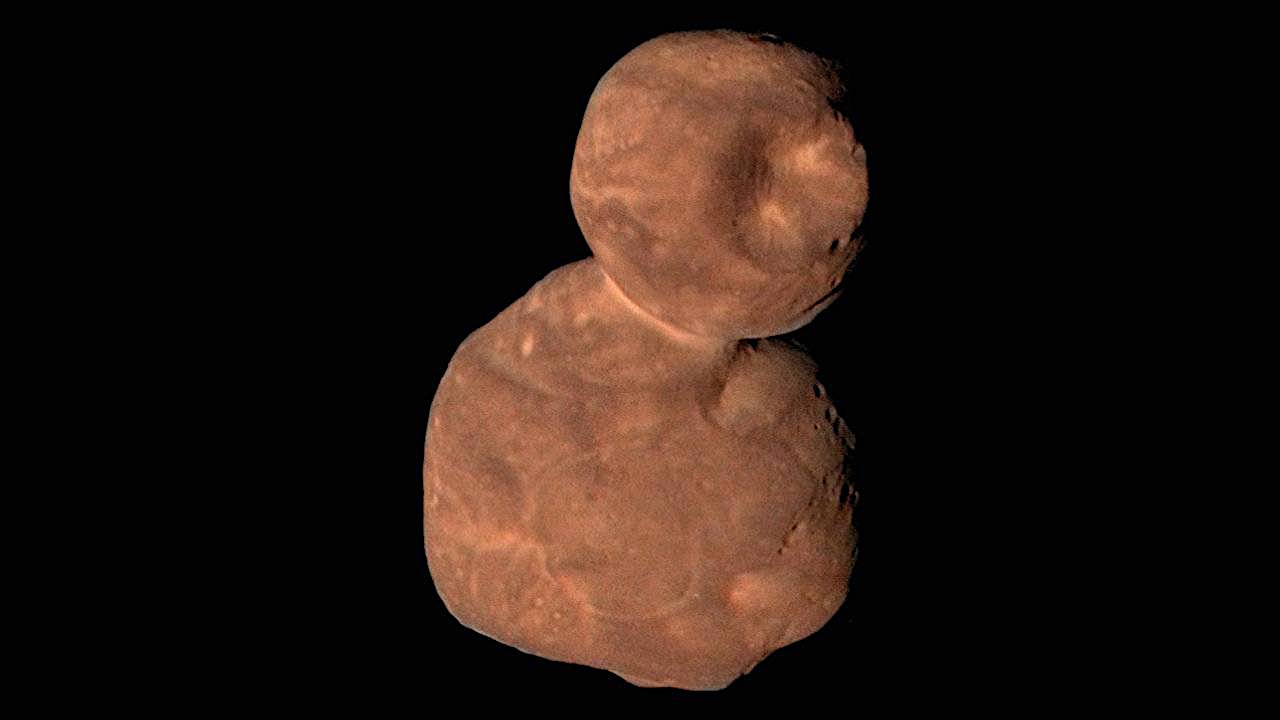 Arrokoth as imaged past New Horizons
Arrokoth as imaged past New Horizons Reading (this cloth covers ii lectures):
- Study Guide 20 Bennett textbook, Chapter 11
Reading for next lecture:
- Study Guide 21 Bennett textbook, Affiliate 12
Web Links:
- The Race for Neptune (MacTutor)
Happy first birthday, Neptune! (2011 marked the end of the showtime Neptunian year, which is
165 Earth years, since it was discovered; come across this congratulatory note from Phil Plait) JPL Photojournal Image Site
Data & Images at Views of the Solar Organization
Selected Images of Europa (O'Connell) The Voyager Missions
- Voyager Gee-Whiz Stuff
Voyager Chiliad Tour Videos
Current locations of Voyager and Pioneer spacecraft
The Giant Planets Satellite Folio
The Cassini-Huygens Mission to Saturn and Titan
- Landing on Titan: Huygens Descent Imager Movies
Songs---yes, songs---about the demise of Pluto
Interview with the "Human Who Killed Pluto" (NPR, "On Signal")
Which Of The Following Shows The Four Jovian Planets Correctly Scaled In Size?,
Source: https://rwoconne.github.io/rwoclass/astr1210/guide20.html
Posted by: ayalasafteph.blogspot.com


0 Response to "Which Of The Following Shows The Four Jovian Planets Correctly Scaled In Size?"
Post a Comment